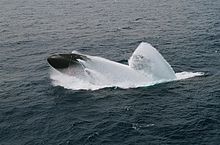Blow out

In sailor's language, blowing out is the term used to describe the complete emptying of the diving cells of a submarine as soon as it has penetrated the surface of the water (at least with a snorkel ). The previous partial emptying of the cells, usually with stored compressed air, is called blowing . The opposite process - the fastest possible descent to enroll approximately before water bombs to safety - called crash dive .
It is blown out with a blow-out device that either directs the exhaust gases from the diesel engine into the diving cells or presses in outside air through a blower. The first case has the advantage that the exhaust gases from the diesel engine have a conserving effect on the inner walls of the immersion cells. Blow-out devices are installed to save compressed air. Since a boat begins to climb with the dive cells only partially depleted, a significant part of the cell volume can be blown out (especially if there is a snorkel).
Blowing out is also called the complete emptying of the diving cells with the help of an emergency blow-out device . Neither stored compressed air nor outside air is used, but gas usually generated by chemical reactions from special gas generators.
Since the angle and rate of climb of the submarine can be very large when it is blown out, the crew must ensure that no parts are flying around inside the submarine.
literature
- Ulrich Gabler: Submarine construction. Bernard & Graefe, Koblenz 1997. ISBN 3-763-75958-1